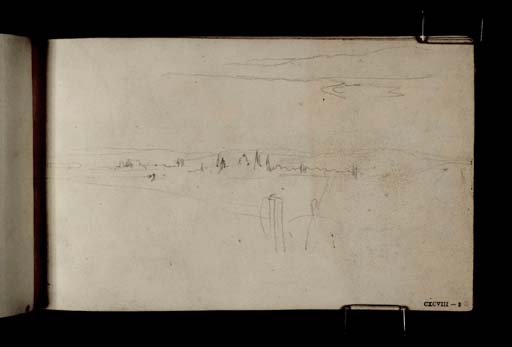Joseph Mallord William Turner A Distant View of Oxford, from the West c.1821-2
Image 1 of 2
Joseph Mallord William Turner,
A Distant View of Oxford, from the West
c.1821-2
Joseph Mallord William Turner 1775–1851
Folio 2 Recto:
A Distant View of Oxford, from the West c.1821–2
D17209
Turner Bequest CXCVIII 2
Turner Bequest CXCVIII 2
Pencil on white wove paper, 113 x 187 mm
Partial watermark ‘T Edm | 18’
Inscribed by John Ruskin in red ink ‘2’ bottom right
Stamped in black ‘CXCVIII – 2’ bottom right
Partial watermark ‘T Edm | 18’
Inscribed by John Ruskin in red ink ‘2’ bottom right
Stamped in black ‘CXCVIII – 2’ bottom right
Accepted by the nation as part of the Turner Bequest 1856
References
1909
A.J. Finberg, A Complete Inventory of the Drawings of the Turner Bequest, London 1909, vol.I, p.604, CXCVIII 2, as ‘Town in distance (Distant view of Oxford)’.
1997
James Hamilton, Turner: A Life, London 1997, pp.209, 326 note 14.
1999
Selby Whittingham, Of Geese, Mallards and Drakes: Some Notes on Turner’s Family: IV – The Marshalls and Harpurs, vol.II, London 1999, p.22.
2000
Colin Harrison, Turner’s Oxford, exhibition catalogue, Ashmolean Museum, Oxford 2000, p.86.
As recognized by Finberg, the main sketch on this page shows a view of Oxford rendered from a position on a distant hillside to the west of the city. Colin Harrison cites this page as marking the beginning of a journey which next moved to Sunningwell on folio 17 recto (D17234) and then returned to Oxford ‘briefly to leave by the London road past Nuneham Courtenay’ (folios 87 verso and 88 recto; D17356 and D17357).1 Harrison describes this group of drawings as ‘rapid notes, and not intended for anything more than to satisfy the artist’s innate need to sketch’.2
Distinctive spires puncture the linear urban profile; St Mary’s church is visible at far left, the dome of the Radcliffe Camera sits in the centre, and All Saints Church, All Souls College, Christ Church Cathedral and Magdalen College appear to the right. In the top right corner of the page is a linear rendering of a landscape with a meandering river visible in the foreground.
James Hamilton observes that Turner travelled to see his widowed aunt in Sunningwell ‘soon after’ the sad event of his uncle’s death in June 1820, in order to administer to her an annuity dictated in the will.3 This chronology, placing Turner in Oxfordshire in late 1820 or early 1821, seems to explain the jotted views of that area which smatter these first few pages of the Folkestone sketchbook. Indeed, Selby Whittingham directly dates this page of the sketchbook and its verso to ‘c.1821’.4
Additional presumed or identified views of Oxford and the surrounding area can be found on the inside front cover, and on folios 1 recto, 1 verso, 2 verso, and 5 recto (D40685, D17207–D17208, D17210, D17214). Turner would return to the present view between 1834 and 1840 in order to produce the finished watercolour Oxford, from North Hinksey (Manchester Art Gallery).5 As part of the Turner Bequest there is also a more abstract impression made from the same direction catalogued among the ‘Oxford Subjects, possibly for “England and Wales”’ in the ‘England and Wales colour studies c.1825–39’ section (Tate D25220; Turner Bequest CCLXIII 98).6 The vantage point shares similarities with those the artist took up in 1839 when making further pencil panoramas of the town in the First Mossel and Oxford sketchbook(Tate D28332–D28334, D28336–D28342; Turner Bequest CCLXXXIX 21a–22, 23a–26a). Eric Shanes suggests that these pencil studies form the preliminary work for the aforementioned abstract rendering.7
Maud Whatley
January 2016
How to cite
Maud Whatley, ‘A Distant View of Oxford, from the West c.1821–2 by Joseph Mallord William Turner’, catalogue entry, January 2016, in David Blayney Brown (ed.), J.M.W. Turner: Sketchbooks, Drawings and Watercolours, Tate Research Publication, February 2017, https://www


